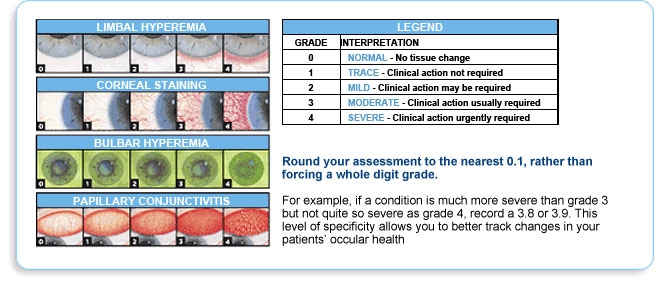Assessing your patients
A combination of probing questions and clinical tools can help you assess the impact of your patients' current lens wear and care routine on their ocular physiology.
Asking specific questions may open the door for a more complete understanding of your patients' health and comfort.
Remember: their eyes might tell you what they don't
Clinical grading scales provide a means of standardised evaluation of key, comfort related physiological measurements, such as:1
-
Limbal hyperaemia
-
Corneal staining
-
Bulbar hyperaemia
-
Papillary conjunctivitis

* Grading scales adapted from Professor Nathan Efron, Eurolens Research, The University of Manchester, UK. Illustrations by Terry R. Tarrant.
Communicate
Talk to your patients about your assessment – including how they score on comfort related physiological measurements – and help them understand the rationale for your recommended contact lens and wear-and-care routine.
There are two key ways to helping your patients stay healthy and comfortable in contact lenses:
The right lens
Refitting your patients' contact lenses may improve their ocular comfort. Advising patients of all available options helps them make more informed decisions.
A combination of probing questions and clinical tools can help you assess the impact of your patients' current lens and wear-and-care routine on their ocular physiology, and determine whether they might benefit from a transition to an alternative lens.
Read our top 10 tips for fitting and upgrading lenses
Proper lens care
Remind your patients that following simple wear-and-care rules can keep their eyes looking bright and healthy. Help your patients stick to your recommended wear-and-care routine.
Transition
Comfort you can see with ACUVUE® Brand Contact Lenses
Determine if your patients might benefit from a move to ACUVUE® OASYS® contact lenses. A recent two-year clinical study has shown these lenses can improve key, comfort related conditions. The study evaluated the impact of ACUVUE® OASYS® on ocular tissue, comparing baseline results against results at 24 months.2
The study included both established hydrogel and silicone hydrogel contact lens wearers (who switched to ACUVUE® OASYS® from their habitual lenses) and non-wearers.
Results
After two years in ACUVUE® OASYS®, wearers experienced significant improvements in comfort related measures of ocular physiology.

Results showed reflect outcomes for the 42 established soft contact lens wearers completing the study. Reductions occurred in both incidence and severity. Images are for illustration purposes only, and do not reflect the grading scale used in the study.
1. Grading scales adapted from Professor Nathan Efron, School of Optometry and Vision Science, Queensland University of Technology Australia. Illustrations by Terry R. Tarrant.
2. Guillon M, Maıssa C. Long-term effects of the daily wear of senofilcon A silicone hydrogel contact lenses on corneal and conjunctival tissues. Optometry (2010) 81, 671-679.


